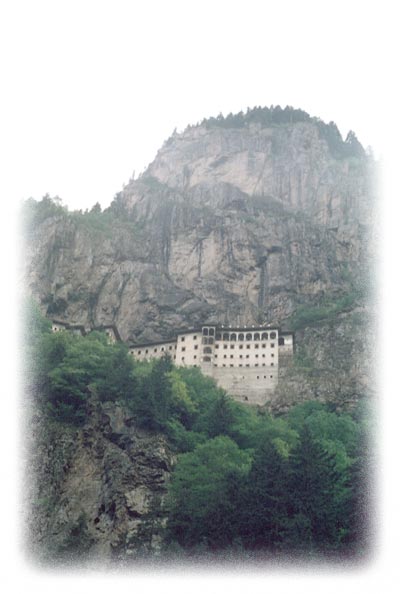| Eastern BlackSea (Trabzon-Rize) Space Images | Road Map | ||||
|
|
|||||
 |
The Sumela Monastery, which stands on the foot of a steep cliff facing the Altindere valley in the region of Maçka in Trabzon province, is populary known as "Meryem Ana" (The Virgin Mary). The building complex is nearly 300 metres high and was built following the tradition of monasteries that were located outside the cities in forests near caves and sources of water.
The Monastery, founded in honour of the Virgin Mary, took the name of "Sumela" which derives from "Melas", meaning black. Althought, it is thought that it has taken this name from the mountains, the Karadaglar (Black Mountains), on which it stands, it could also associated with the black colou of the icon of the Virgin Mary. According to tradition, the Monastery was founded by two priests caled Barnabas and Sophronius who came from Athens during the reign of the Emperor Theodousius I (AD 375-395). Then, in the 6th century, it was restored by the General Belisarius at the behest the Emperor Justinian who wanted it to be enlarged and restored. The Monastery reached its final, present form in the 13th century . It gained importance during the reign of Alexios III (1349-1390) of the Comnenian Empire of Trabzon, which had been established in 1204. Its income was assured from imperial funds. During the time of Manuel III, son of Alexios III, and the reign of later princes, Sumela gained further wealth from new imperial grants. Like most other monasteries, the rghts of the Sumela Monastery were preserved by the Ottoman Sultans ans some special priveleges were given after Eastern Black Sea Coast came under domination of the Turks. During the 18th century the many parts of MOnastery were restored and the walls were decorated with frescoes. In the 19th centu, the Monastery took on an impressive appearance which addition of larger buildings. This was the Monastery's heyday and it attracted many foreign travellers who mentioned it in their writings. The Monastery was seized by the
Russians during the occupation of Trabzon between 1916-1918, and then
in 1923 it was completely abandoned. |
||||
|
SUMELA WEB SITE SECTION - CONTENTS:
|
|||||
|
|
|||||
| Of | |||||
